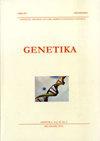尼日利亚富拉尼生态型鸡质量和数量性状的形态学变异
4区 农林科学
Q3 Agricultural and Biological Sciences
引用次数: 0
摘要
对富拉尼生态型(本土)鸡的研究对于正确理解其在尼日利亚未来育种计划中的潜力是必要的。60只成年富拉尼生态型鸡,包括22只雄性和38只雌性,来自奥贡州奥代达地方政府区奥佩吉的富拉尼kraal,用于测定其质量和数量性状。从原始的22只公鸡中随机抽取20只公鸡进行精液质量评估。结果显示,26.67%的人群存在多指畸形。羽毛颜色以棕色和深棕色为主,分别占48.34%和33.33%。梳型以单株为主(85%),刺型占46.67%。羽毛颜色对宜居性和异常有影响(p0.05)。棕色羽毛的精子活力(88.50 ~ 0.89%)和pH(7.01 ~ 0.01)最高(p<0.05),与棕黑色相似。毛色为浅棕色的富拉尼公鸡精子浓度最高(1.90 ~ 0.11 ~ 109/ml),深棕色的富拉尼公鸡精子浓度最低(1.54 ~ 0.11 ~ 109/ml) (p<0.05)。109 /毫升。浅棕色鸡的精液量(0.21±0.01/ml)高于深棕色鸡(0.14±0.01/ml) (p<0.05)。在所有的线性身体测量中观察到中等到高度的正相关。该研究得出结论,富拉尼鸡存在很高的表型多样性,可以用于改进尼日利亚的育种和保护计划。鸡的体重与其他线性体测量呈高度正相关。然而,羽毛较轻的富拉尼生态型公鸡可以在繁殖计划中采用,在繁殖计划中,精液的活力和浓度是至关重要的。本文章由计算机程序翻译,如有差异,请以英文原文为准。
Morphological variations in qualitative and quantitative traits of Fulani ecotype chickens in Nigeria
The study of Fulani ecotype (indigenous) chicken becomes necessary for proper understanding of its potentials for future breeding programmes in Nigeria. Sixty adult Fulani ecotype chickens comprising 22 males and 38 females were sourced from the Fulani kraal at Opeji in Odeda Local Government area of Ogun State and used to determine their qualitative and quantitative traits. Twenty (20) cocks out of the original 22 were selected randomly from the population for semen quality assessment. Results indicated that polydactyly was observed on 26.67% of the population. Brown and dark brown plumage colours were dominant and had an occurrence of 48.34% and 33.33%, respectively. Comb type was predominantly single (85%) while 46.67% of the population had Spur. Plumage colour influenced (p<0.05) comb length, comb width, earlobe width and tail length while shank colour had significant (p<0.05) effect on earlobe length, wattle length, wattle width, tail length. Plumage colour had significant (p<0.05-0.01) effect on sperm motility, semen pH, sperm concentration and semen volume but not (p>0.05) on livability and abnormality. Brown plumage had the highest (p<0.05) sperm motility (88.50?0.89%) and pH (7.01?0.01) which was similar to brown black. Fulani cock with light brown plumage colour had the highest (p<0.05) sperm concentration (1.90?0.11?109/ml) while dark brown had the least value 1.54?0.11? 109/ml. Light brown chicken recorded higher (p<0.05) semen volume (0.21?0.01/ml) when compared with the dark brown chicken (0.14?0.01/ml). Medium to high positive correlations were observed among all linear body measurements. The study concluded that there existed high phenotypic diversity in Fulani chickens and could be exploited for improved breeding and conservation programmes in Nigeria. The body weight and other linear body measurements of the chickens are highly and positively correlated. However, lighter plumage Fulani ecotype cocks could be adopted in multiplication program where semen motility and concentration are paramount.
求助全文
通过发布文献求助,成功后即可免费获取论文全文。
去求助
来源期刊

Genetika-Belgrade
AGRONOMY-GENETICS & HEREDITY
CiteScore
1.80
自引率
0.00%
发文量
1
审稿时长
6-12 weeks
期刊介绍:
The GENETIKA is dedicated to genetic studies of all organisms including genetics of microorganisms, plant genetics, animal genetics, human genetics, molecular genetics, genomics, functional genomics, plant and animal breeding, population and evolutionary genetics, mutagenesis and genotoxicology and biotechnology.
 求助内容:
求助内容: 应助结果提醒方式:
应助结果提醒方式:


